Step-by-step instructions for grafting an apple tree in the summer for beginners
In case of aging or illness of a favorite productive apple tree, it is possible to rejuvenate it and even get several identical specimens. Usually, the propagation of a fruit crop is carried out by one of the available methods - cuttings. For a novice gardener, this process is not difficult if you follow the instructions. The procedure is usually carried out in the fall or spring, but what if it was required in the summer? How to cut an apple tree in the summer, we will tell in the article.
The content of the article
- Is it possible to propagate an apple tree by cuttings in summer
- Optimal timing for summer cuttings
- Suitable varieties of apple trees
- Selection and preparation of cuttings
- Planting ready-made cuttings
- Features of cuttings depending on the type of apple trees
- Further care
- Experienced gardening tips
- Conclusion
Is it possible to propagate an apple tree by cuttings in summer
In order for fruits to ripen on a personal plot every year, the trees need to be updated. Experienced gardeners often rejuvenate or grow a garden vegetatively with green cuttings.
This method can be considered a kind of cloning. It makes it possible to obtain healthy and genetically pure planting material, does not require funds for the purchase of new seedlings.
Although the survival rate of cuttings, according to various sources, ranges from 30 to 60%, it is possible to harvest them in large quantities. As a result, the required number of seedlings is obtained.
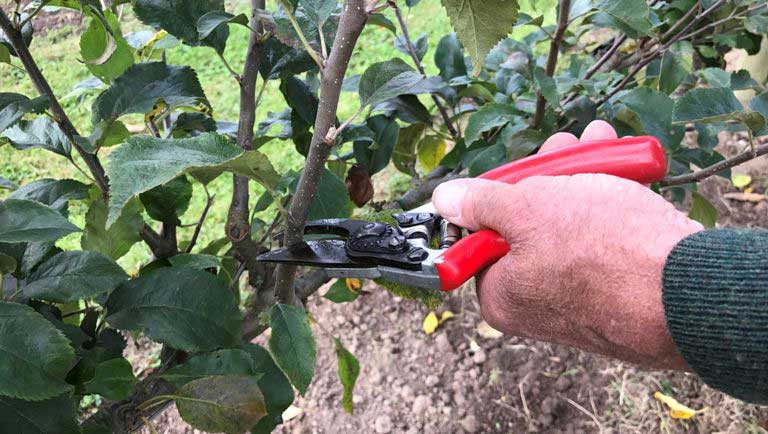
Advantages and disadvantages
Gardeners include the following benefits of the procedure:
- The possibility of multiplying fruit crops at home.
- Preservation of varietal characteristics of the mother tree: taste, fruit size, resistance to diseases, climatic conditions, keeping quality.
- Reproduction of any variety of apple trees, including columnar.
- Cuttings of self-rooted and grafted apple trees are suitable.
- Increase in the amount of harvest without additional cash costs.
- The ability to reproduce an apple tree at any age.
- Cuttings keep well and are easily transported over any distance, unlike ready-made seedlings.
- Advantages over grafted trees: the taste of the fruit is sweeter, the yield is greater, long-term fruiting.
The only drawback of propagation by green cuttings is the long rooting period (2 years) and troublesome care.
Optimal timing for summer cuttings
The best time for the procedure is June, July, when the shoots have not yet had time to completely lignify (such are more willing to give roots). These are the months with the longest daylight hours. In addition, the cuttings will have enough time to take root (2-3 months) and grow stronger. Subsequently, they will painlessly survive the winter.
At a later date, when the growing phase of the plant comes to an end, almost one third of the shoots for harvesting loses the ability to take root safely.
Auspicious days
Knowing the favorable days of the lunar calendar, it is much easier to plan the implementation of the event, which will give you the opportunity to get a decent harvest of juicy and tasty apples. Days by month:
- June - 1-4, 22-30;
- July - 1-4, 21-31.
Suitable varieties of apple trees
Choosing the right variety for propagation is one of the main criteria for a good apple harvest.
Altai ruddy
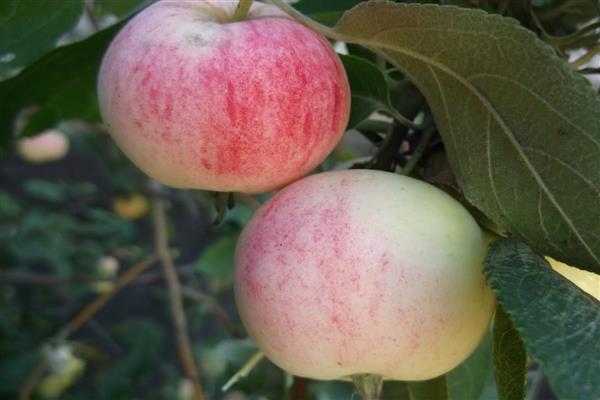
Apple tree of late summer ripening, obtained thanks to the work of breeders of the Altai Territory. Outwardly beautiful tree with a medium-sized trunk and a compact spherical crown.The branches of the apple tree are large, powerful, directed vertically upward. On them, ringlets grow evenly, on which the crop is formed and ripens.
Fruits are small - from 55 to 100 g. The color of apples is light red with creamy inclusions. The pulp is light yellow in color, juicy sweet and sour taste with a pleasant light aroma. With proper observance of the temperature regime, the fruits are stored for a long time (up to 60 days). The variety is endowed with good winter hardiness.
Zhigulevskoe
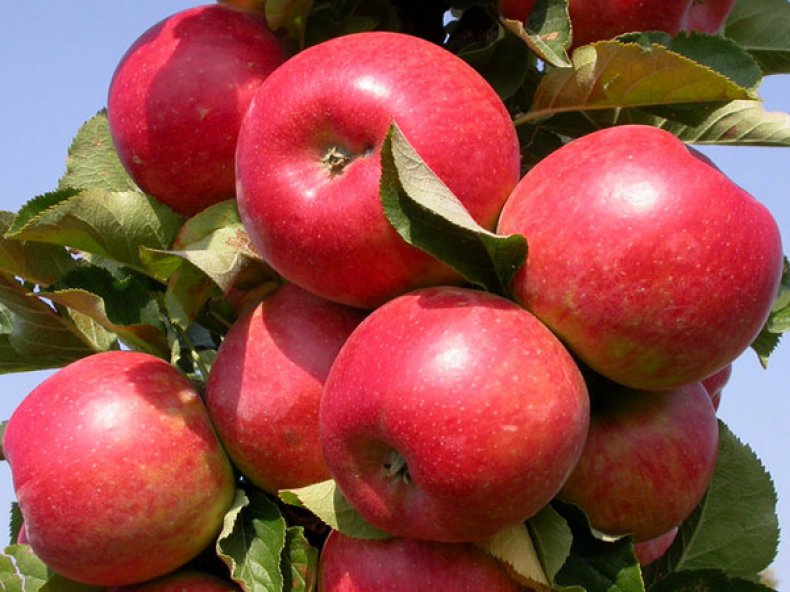
The apple tree belongs to the late autumn varieties. It became famous as a large-fruited culture. A tree of regular shape with large flowers, leaves and fruits up to 200 g, sometimes up to 300 g.
The skin of apples is smooth and firm, unevenly colored: golden yellow with a reddish striped blush. The shelf life of fruits is 2-3 months, the yield is high - up to 250 kg per season from one tree.
Pepin saffron
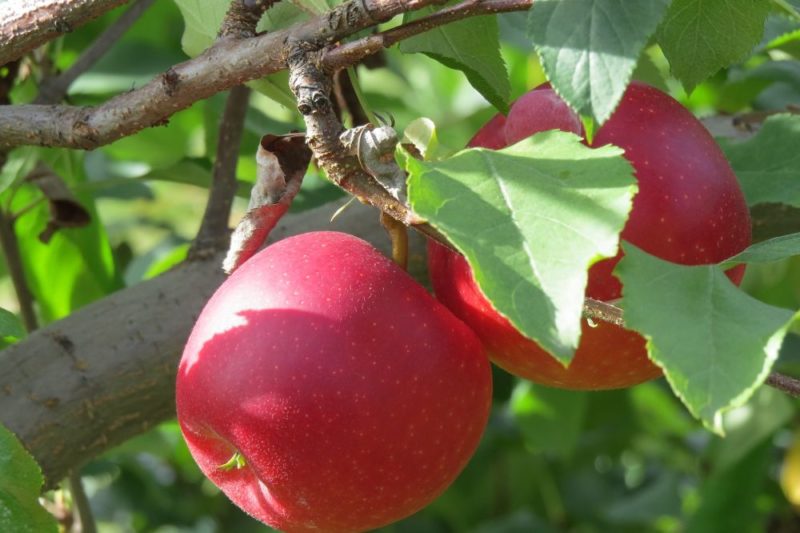
The variety, familiar to almost all gardeners in Russia, was bred by the great breeder I. V. Michurin. Thanks to its ideal taste and adaptability, it has become a leader in demand in private gardening. The tree is medium-sized - up to 3 m.
The apples are of the correct rounded-conical or oblong-ovoid shape, very tasty and attractive in appearance. When mature, they acquire an even crimson hue. The fruits are well kept fresh and when transported over long distances. The weight of apples ranges from 90 to 130 g.
The yield is regular and very high: at a young age - 50-70 kg, maximum - 305 kg.
Selection and preparation of cuttings
The breeding procedure begins by examining the apple tree for diseases and injuries. If the tree is healthy, choose high-quality strong shoots, from which cuttings are cut. A very sharp knife or pruner is used to separate them.
Green cuttings
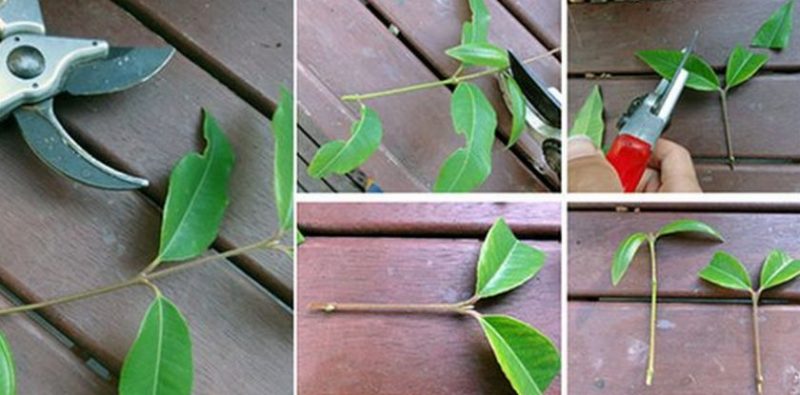
The event is held in June - July in the morning, until the moisture evaporates from the plants. In the lower tier of an apple tree not older than 10 years, young annual shoots are selected, the lower part of which has already begun to wood. In this case, all leaves, except for the top one, should be open.
Cuttings 20-30 cm long are cut so that the lower cut at an angle of 45 ° is above the kidney, and the upper (straight cut) is 10 mm higher than it. At least 3 leaves must be left on each cut off part. One is removed, the other 2 are cut in half. Future seedlings are kept in a growth stimulant solution for 18 hours.
Lignified cuttings
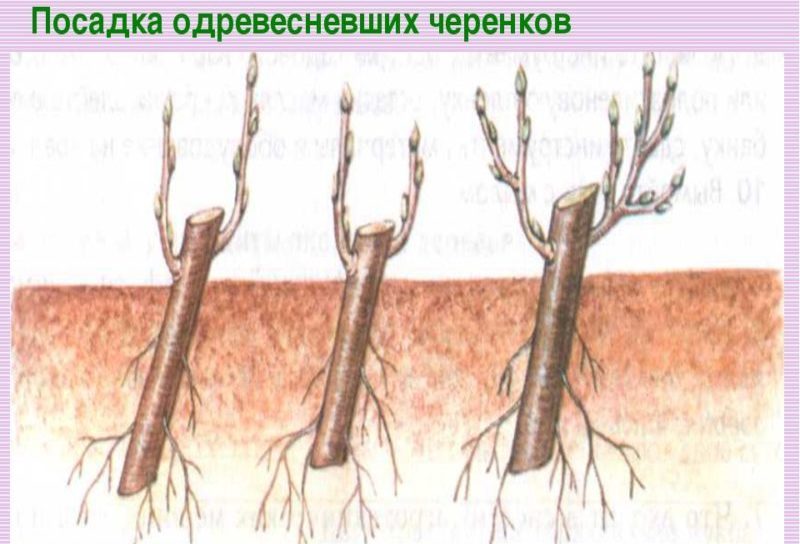
At the end of December, healthy annual or biennial shoots are selected in the middle tier of the tree from the south or east side and break them in several places with an interval of 15-20 cm without damaging the bark.
The fracture sites are fixed by applying a bandage made of plaster, electrical tape, or other suitable material. Growth substances will be directed to the injured places for the healing of fractures. In early spring, cuttings are cut in places of fractures at an angle and placed on rooting.
Air layering
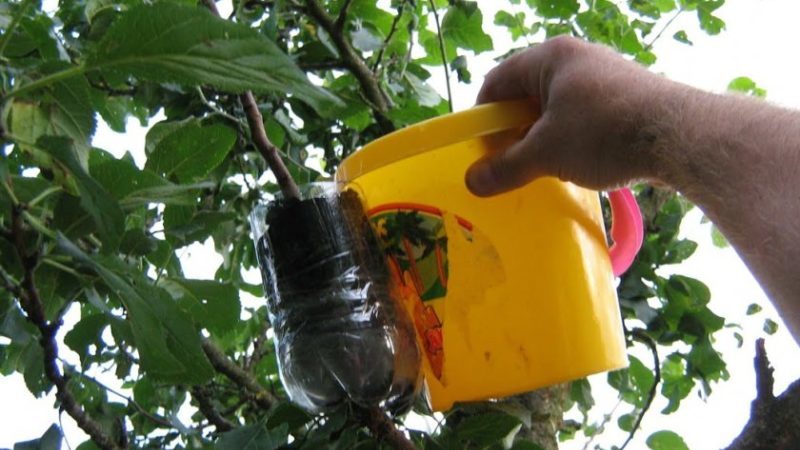
The technology is based on the characteristics of the cambium tissue, which is located between wood and bark. It is able to form roots in damaged areas of the shoot. In early spring about 20 cm recede from the top of the process and all the leaves are cut off, the bark ring is removed to treat with a stimulating solution.
An open section of wood is wrapped with wet moss and fixed with electrical tape. When the sap flow begins, the growth is removed from the air layer. As roots appear in a bare place, the shoot is cut off from the mother branch and planted in open ground.
Reference. To stimulate the formation of roots, use such means as "Zircon" or "Kornevin".
Ways to root them
How to propagate an apple tree after stimulating the root system:
- Green cuttings are planted in a box, 20 cm filled with nutritious soil, for example, black soil, and 5 cm from above - with calcined sand (for the purpose of disinfection).The substrate is moistened and cuttings are planted to a depth of no more than 2 cm, maintaining a distance between them of about 5 cm. A greenhouse is built above the box and placed in partial shade.
- Lignified cuttings are rooted in opaque containers (for example, dark plastic bottles with the neck cut off). A porous sponge is placed on the bottom, soft water (melt or rain) is poured in a layer of 5 cm, 2 tablets of activated carbon are added and left on the windowsill until roots appear. Then sent to partial shade. By the beginning of autumn, ready-made apple seedlings are obtained from lignified shoots.
Easier and more interesting methods of growing apple seedlings are known, for example, in a potato tuber. In this unusual way, cuttings receive all the nutrients they need to stimulate growth.
Take a large tuber without eyes and stick a stalk with one or two buds into it. The tuber is buried in the ground, watered and covered with a plastic jar or bottle. Periodically, the greenhouse is ventilated, the soil is moistened. As practice shows, with this method, the cuttings take root quickly.
Planting ready-made cuttings
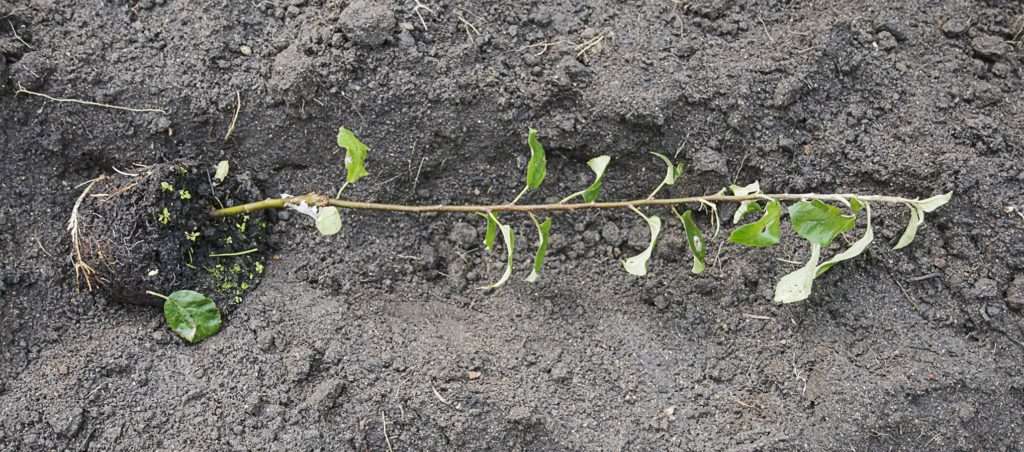
When the roots reach 5-8 cm, the cuttings begin to prepare for planting outside. In an open area, dig holes, fill them with earth and sawdust. Dry sand is poured on top with a layer of 10 cm, which will prevent the germination of weeds and improve soil aeration. Place any covering material or plastic containers on top.
The trench method is often used (planting seedlings in trenches prepared in advance and filled with fertilizers), because the more numerous the planting, the more likely it is to get a full-fledged apple tree. After planting in the ground, the seedlings are fed with chicken manure or nitrogen fertilizer, abundantly watered, loosen and cover the soil with a layer of mulch, which saves moisture.
Features of cuttings depending on the type of apple trees
The apple tree is classified as a difficult-to-root crop. Wild species and rootstocks, when cultivated, give a decent amount of seedlings, while domestic varieties take root and take root worse.
Among all varieties, the columnar apple tree stands out. She has earned great recognition from gardeners. The apple tree has a compact crown, making it ideal for smaller gardens. The process of growing an apple tree from cuttings is the same as for other types of crops. The difference lies in the need for rooting only in summer. In autumn and winter, planting cuttings does not end with a positive result.
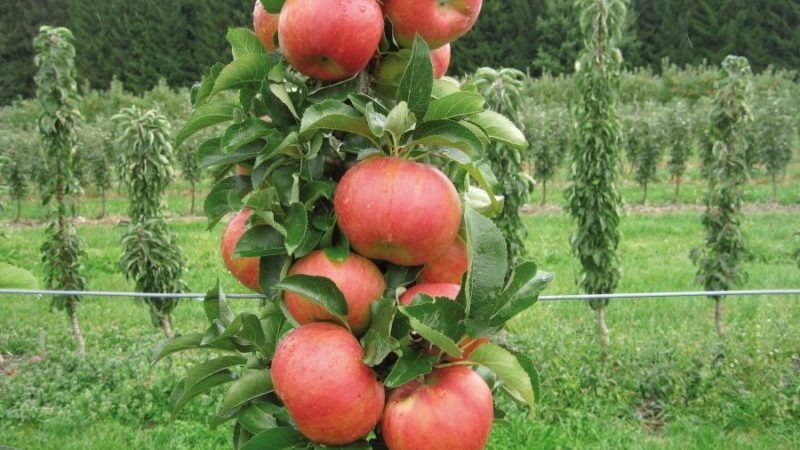
Depending on the region
In the northern regions, cuttings are performed in the first half of July. So the seedling will have time to form a powerful root system and gain strength before the onset of cold weather.
In the middle lane and southern latitudes of Russia, cuttings are carried out in June or July.
Further care
Seedling care after landing is as follows:
- If the length of the branches is more than 35-40 cm, and the seedling itself is powerful and strong, pruning spend in the first year of life. If the seedling is weak, it is performed the next season.
- The central trunk is cut into 4 buds, leaving side branches.
- In the first months, the soil moisture level is monitored. In hot and dry weather, the seedlings are watered once a week.
- It is especially important at the very beginning to monitor the possible occurrence of diseases and to process the tree in time.
- At the beginning of autumn, 2 buckets of humus are poured into the trunk circle. This will allow the plant to strengthen and survive the winter safely.
Experienced gardening tips
Basic tips for growing an apple tree from experienced gardeners:
- For better rooting, the moisture content of the workpieces is constantly monitored.
- Use only clean and treated garden tools.
- June is considered the most suitable time for harvesting planting material.
- Top dressing applied carefully, observing the required dosage. If it is exceeded, the plant may die.
- To get high-quality planting material, the cut is done early in the morning.
- When rooting, cuttings often lose leaves. This is not scary, because just one sheet is enough.
Conclusion
Cutting an apple tree in the summer may seem like a difficult and ineffective process, but it is not. This technique requires mastering several operations, after which it becomes simple even for novice gardeners. The main thing is to correctly prepare the planting material and provide proper care.